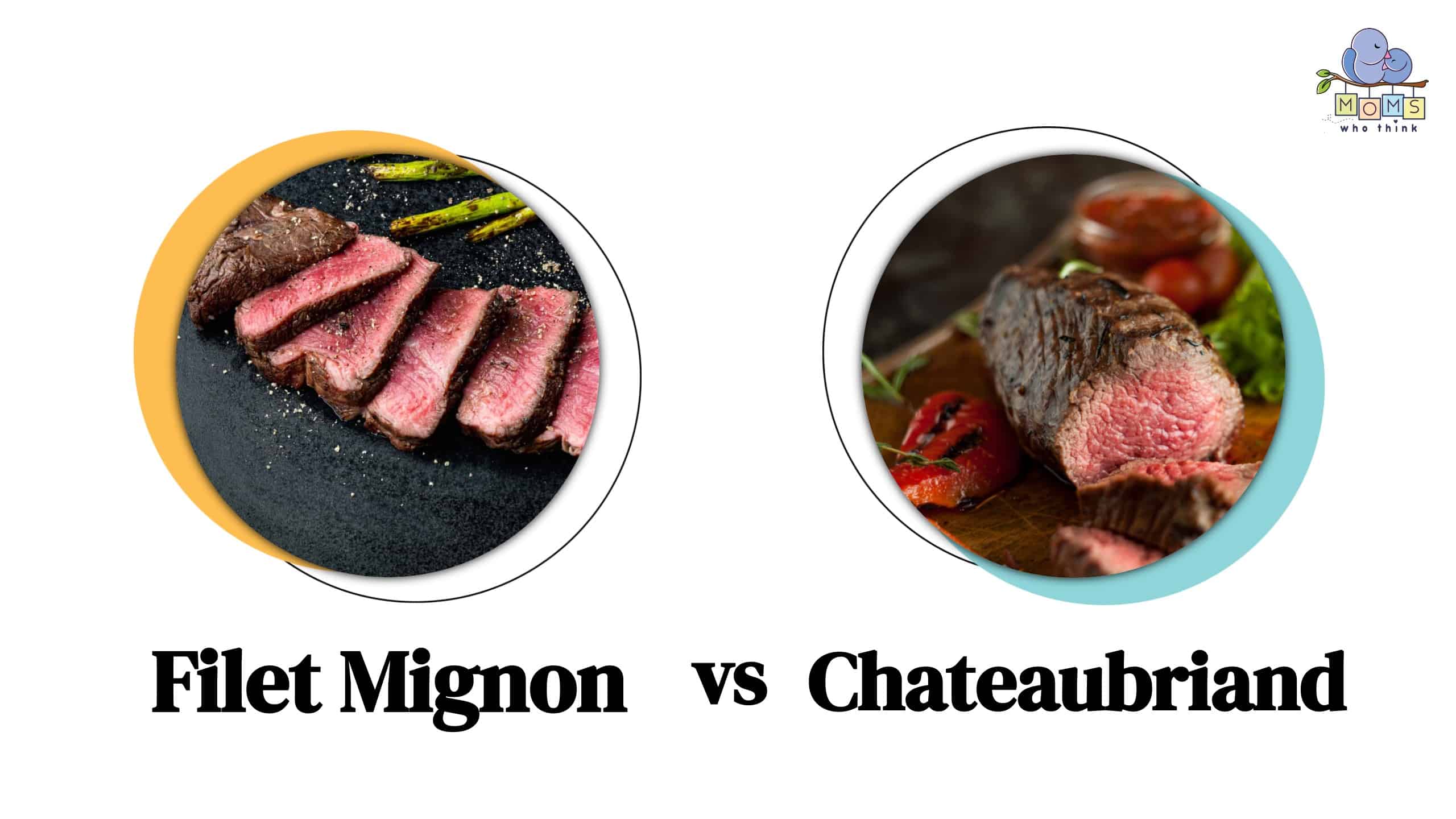If you're looking to indulge in a mouthwatering and ultra-tender steak, chances are you've come across two popular choices: Chateaubriand and filet mignon. But you may have wondered what sets these two cuts of beef apart.
Both chateaubriand and filet mignon share a common origin—the tenderloin—but each cut offers its own distinct flavor, texture, and dining experience. Whether you're planning a special family celebration or simply seeking to expand your knowledge, this post explores the contrasts between chateaubriand and filet mignon. Let's dive in!
- The must-have convenient reference guide for every home cook!
- Includes more than 8,000 substitutions for ingredients, cookware, and techniques.
- Save time and money on by avoiding trips to grab that "missing" ingredient you don't really need.
Chateaubriand vs. Filet Mignon: What Is the Difference?
As mentioned, both chateaubriand and filet mignon are cut from the same area of beef, the tenderloin. So while they are both very tender meats, they have other defining characteristics that set them apart. Filet mignon, for example, is cut into a small, medallion size and is typically grilled or pan-seared. On the other hand, the chateaubriand is cut into a very large portion (usually enough for 2-3 people) and is often roasted.
Let's take a closer look at each of these beef cuts.
What Is Chateaubriand?
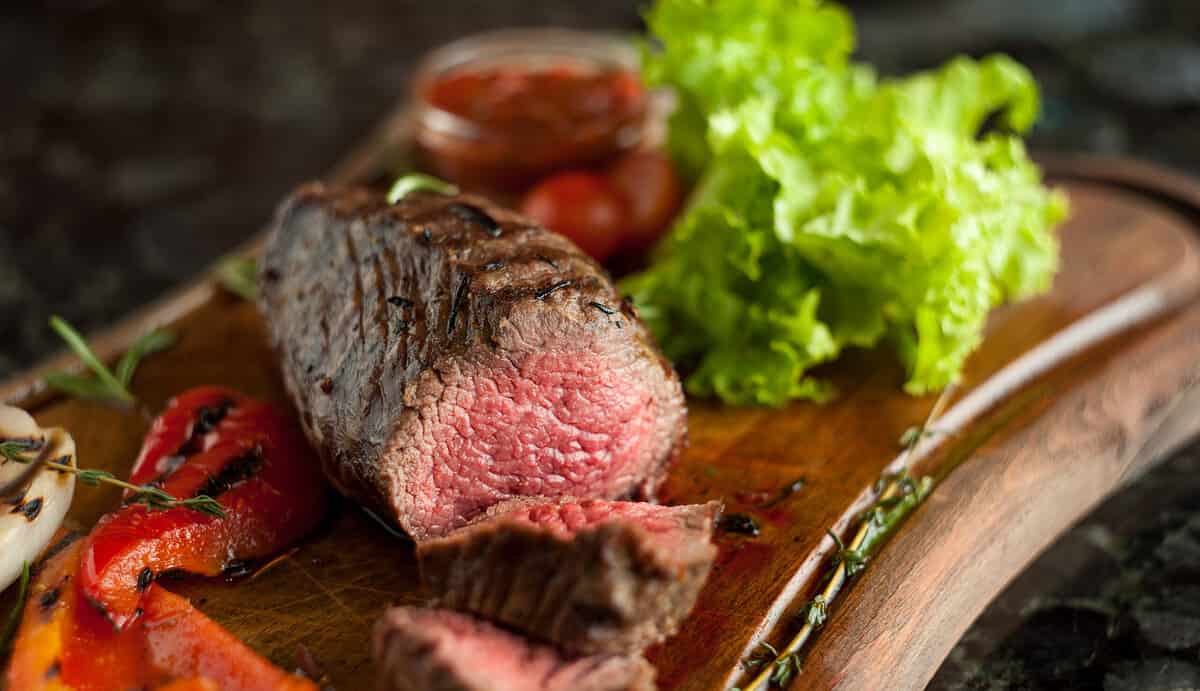
Chopped steak chateaubriand
©Romans14/Shutterstock.com
Chateaubriand (pronounced shah-toe-bree-ond) is named after François-René de Chateaubriand, a renowned French writer and diplomat who lived during the French Revolution and into the 1800s. This meat is typically a very large cut of beef, which can often cause it to be called a roast rather than a steak. Chateaubriand also has a very specific cooking method that sets it apart. Here's what you need to know about this cut of beef.
Meat Cut
As mentioned, chateaubriand is cut from the tenderloin of a cow, which is a longer, cylindrical muscle that runs along the spine of the cow. Chateaubriand is typically cut from the thickest part of the muscle closer to the animal's head.
Texture and Appearance
The chateaubriand cut is often a thick, wide steak, typically weighing between 1.5 to 2 pounds. Due to its larger size, it's often served with the intention of being shared between two or more people. This large size also makes it an excellent choice for a centerpiece during a family meal or extravagant dinner.
What the chateaubriand is most known for is its extreme tenderness. Because the tenderloin is a muscle that doesn't get much use, cuts of meat that come from this area are exceptionally tender. Its fine texture practically melts in your mouth.
Flavor
While chateaubriand is known for its buttery tenderness, it's not as flavorful as other cuts of meat due to the lack of marbling. According to this article from MasterClass, marbling is “the white flecks of intramuscular fat in meat, most notably red meat.” Therefore, the chateaubriand is known for its mild and delicate taste.
Additionally, the chateaubriand is often cooked more like a roast (as we'll discover next), which means that the flavor tends to be different from a steak. If roasted, this cut of meat can have a caramelized exterior with a juicy and slightly sweet interior.
Cooking Method
As mentioned, the chateaubriand is often roasted, but it can also be grilled or pan-seared depending on preference. It is also often served with a sauce. Béarnaise is a popular French sauce that is similar to Hollandaise with shallots and tarragon. A red wine reduction sauce or Dijon mustard sauce are also great options to serve along with the chateaubriand to compliment its flavor without being too overpowering.
When roasting a chateaubriand, it can be pan-seared first. Just be sure the outside is crispy but not burned, and the inside is moist and juicy. Here are a few tips to make sure your chateaubriand is roasted to perfection:
- Let your meat come to room temperature, then pat it dry and add your preferred seasonings before pan-searing it.
- Place your chateaubriand in the oven to roast, and cook until your desired doneness. Traditionally, this meat is cooked to medium-rare, which is an internal temperature of 125 degrees to 135 degrees. However, the FDA recommends cooking all meat to an internal temperature of 145 degrees for safety.
- After your meat is done cooking, cover it with foil and let it rest for up to 15 minutes before slicing and serving.
What Is Filet Mignon?
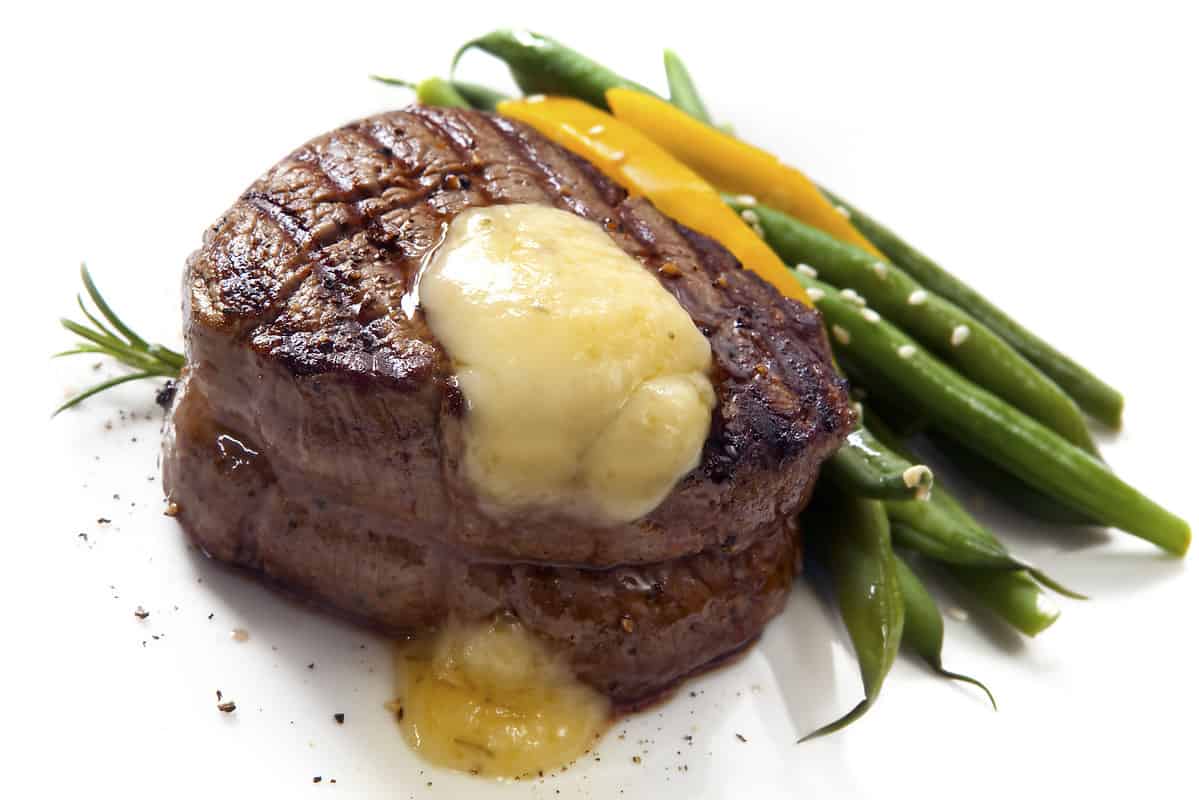
Filet mignon is typically a small medallion-sized cut.
©iStock.com/robynmac
In French, filet translates to “cute” and mignon translates to “dainty” or “small.” These words perfectly sum up the steak we're familiar with today. Filet mignon is a cut of beef that is most known for its tenderness and delicate flavor. Here's a closer look at its specifics.
Meat Cut
Like chateaubriand, filet mignon is cut from the beef tenderloin. However, while chateaubriand is cut from the thicker portion, the filet mignon is cut from the smaller end of the beef tenderloin. The tenderloin is not a heavily used muscle which results in very little connective tissue or fat. Less connective tissue is what makes both of these meats known for their incredible tenderness.
- The must-have convenient reference guide for every home cook!
- Includes more than 8,000 substitutions for ingredients, cookware, and techniques.
- Save time and money on by avoiding trips to grab that "missing" ingredient you don't really need.
Texture and Appearance
Like chateaubriand, one of filet mignon's defining characteristics is its tenderness. This cut of beef has a very soft, buttery texture. Filet mignon is typically cut and sold at 1-2 inches thick. They are typically small, weighing in at around 6-8 ounces, but they can be cut thicker or thinner depending on preference.
Flavor
Similar to chateaubriand, filet mignon's cut is not from a weight-bearing muscle which means it's tender, but it doesn't contain a high amount of fat. The lack of marbling can also make this cut of beef more prone to drying out if overcooked. Filet mignon has more of a delicate flavor and less of a strong beef flavor.
Cooking Method
Filet mignon can be prepared in a variety of ways, but it is most commonly grilled, broiled, or pan-seared. Because it doesn't have as strong of a flavor, it's often served with a rich sauce or topping, such as a red wine reduction or compound butter.
In general, filet mignon can handle a higher heat due to the fact that it has a lower fat content. Most often, high heat is first applied to sear both sides of the meat. Then it's left to cook at medium heat until it reaches the desired doneness.
Here are a few quick tips to cooking filet mignon in different ways:
- Grilling: Grill the filets for about 3-4 minutes per side for medium-rare, or until they reach the desired level of doneness. Let them rest for a few minutes before serving.
- Pan-seared: Heat a heavy skillet over high heat and add a small amount of oil. Sear the steaks for about 3-4 minutes per side for medium-rare, or until they reach the desired level of doneness. Finish them off with some butter and herbs in the pan to add flavor.
- Oven Roasted: Preheat your oven to 400°F and season the steaks with salt and pepper. Heat an oven-safe skillet over high heat and sear the steaks for 2-3 minutes per side. Transfer the skillet to the oven and roast for 6-8 minutes, or until the desired level of doneness is reached.
Chateaubriand vs. Filet Mignon Nutrition: Which is Healthier (Calories, Fat, Cholesterol)
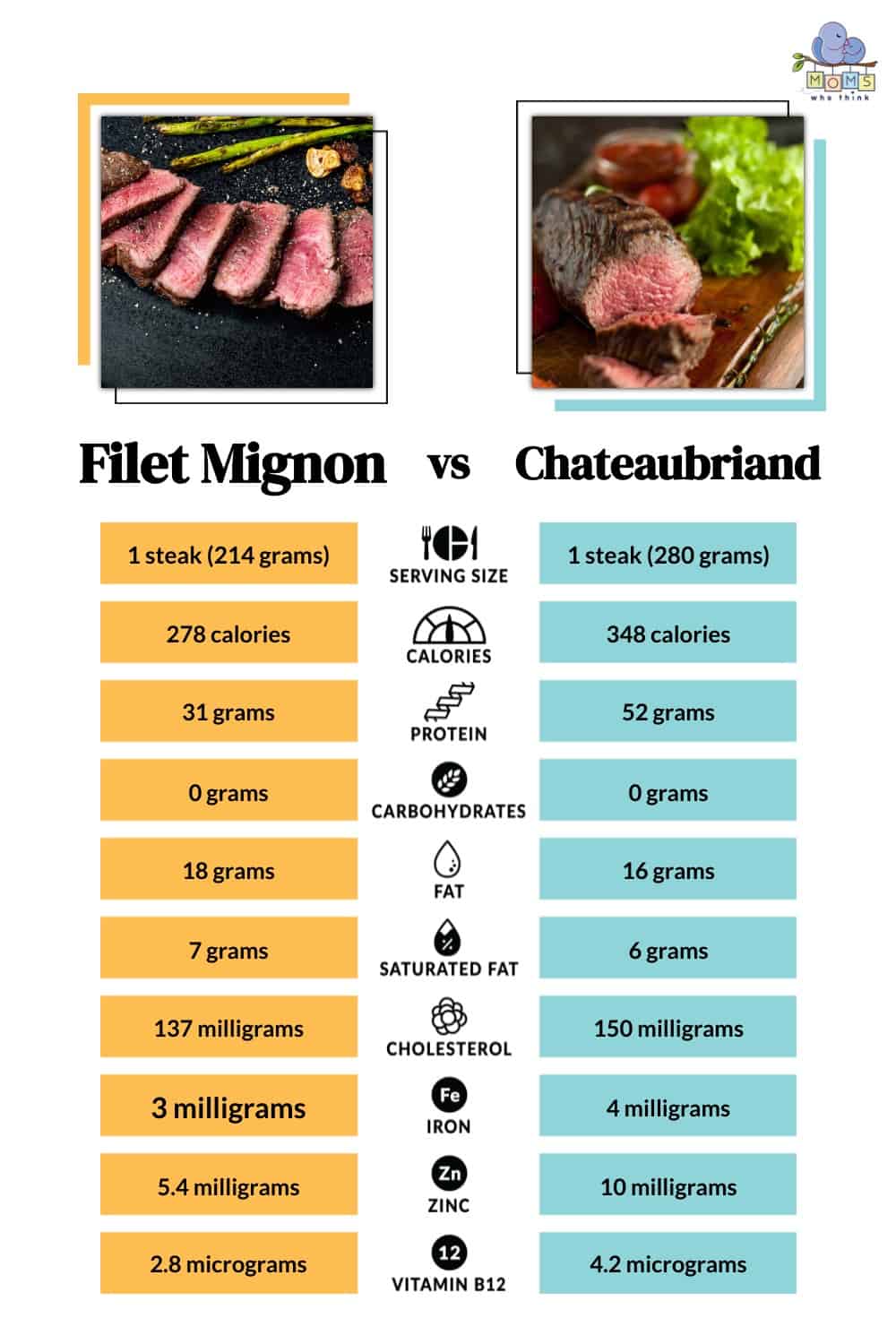
When it comes to nutrition, both filet mignon and chateaubriand are quite similar. A 7-ounce cut of filet mignon will have about 278 calories while a 10-ounce cut of chateaubriand will be closer to 348 calories. Both steaks are heavy in protein and have a fair bit of cholesterol. One benefit of steak is that its rich in vitamins and minerals like iron, zinc, and Vitamins B6 and B12.
Are Chateaubriand and Filet Mignon the Same Thing?
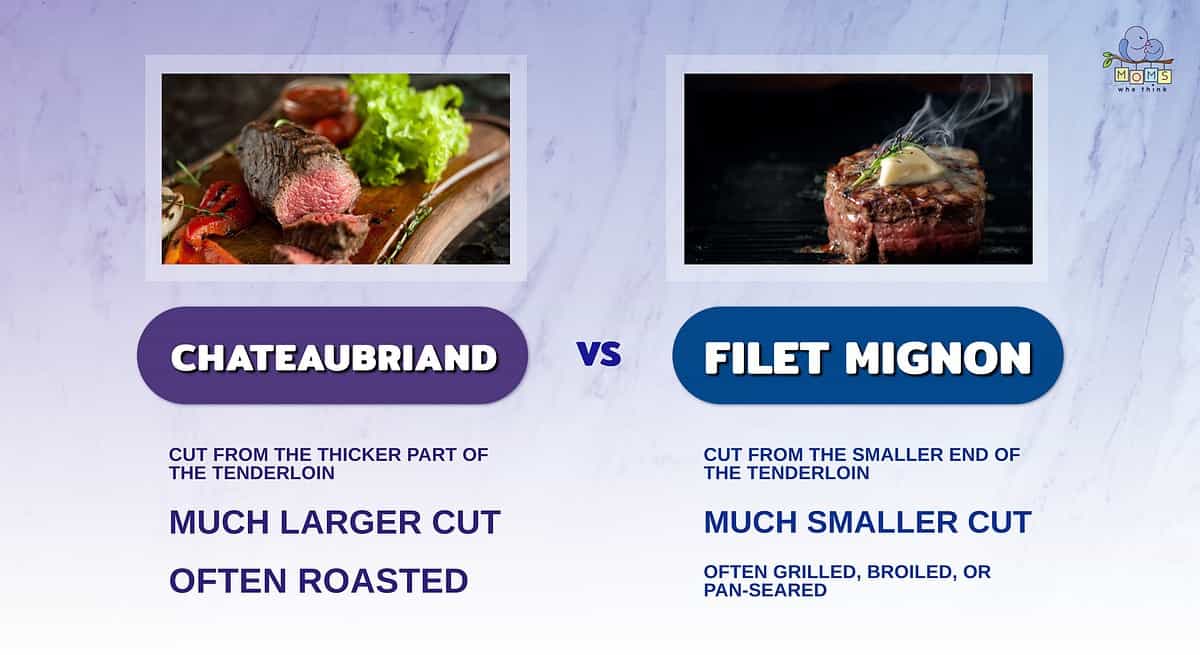
- Chateaubriand and filet mignon both come from the tenderloin, but from different parts. Chateaubriand is cut from the thicker part of the tenderloin, while filet mignon comes from the smaller end of the tenderloin.
- Filet mignon is a much smaller cut compared to Chateaubriand, often coming in at just 6-8 ounces against Chateaubriand's 1.5 – 2 pounds.
- Due to its size, Chateaubriand is often roasted. Meanwhile, filet mignon is commonly grilled, broiled, or pan-seared.
While chateaubriand and filet mignon share a couple of similarities – like both cuts coming from the tenderloin which makes both of these meats extremely tender to eat – they also have several differences that make them unique.
Chateaubriand is a larger, thicker cut that's meant to serve two or more people and makes a beautiful and delicious centerpiece for family or group dining. Filet mignon is a much smaller medallion cut that's suitable for individual use. Additionally, the chateaubriand is great for roasting, but if you're looking to grill or pan-sear your steak, you may want to opt for the filet mignon.
While these cuts of meat are not identical, they are both delicious and tender choices for your next family meal.
Steak Recipes
Print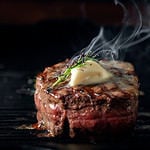
Skillet Beef Pot Pie
Ingredients
1 Pillsbury refrigerated pie crust
2 (8 ounce) filet mignons (needed for tenderness in a short period time)
salt and pepper
2 Tablespoons vegetable oil
1 onion, minced
8 ounces small mushrooms, halved
¼ cup flour
2 garlic cloves, minced
½ cup dry red wine
2½ cups chicken broth
1 Tablespoon tomato paste
1½ teaspoons minced fresh thyme
2 cups frozen peas and carrots, thawed
Instructions
1. Preheat oven according to pie crust directions.
2. Season filets with salt and pepper. Heat 1 Tablespoon oil in 12 inch skillet over medium-high heat.
3. Brown steaks on both sides, leaving centers rare, about 4 minutes total.
4. Transfer to plate, let cool. Cut into ½ inch cubes.
5. Add remaining tablespoon oil, onion, mushrooms, and ½ teaspoon salt to skillet. Return to medium heat and cook until onion is softened, about 5 minutes.
6. Stir in flour and garlic and cook, stirring constantly, until flour is well blended (about 1 minute).
7. Stir in wine and cook until evaporated, about 30 seconds.
8. Slowly whisk in broth, tomato paste, and thyme. Bring to a simmer.
9. Cover and cook over medium-low heat until thickened, 8 to 10 minutes.
10. While sauce is simmering, unfold pie crust dough and place onto a nonstick baking sheet. Bake according to package directions.
11. Stir peas and carrots and beef with juices into skillet. Continue to simmer until heated through, about 2 minutes. Season with salt and pepper to taste.
12. When pie crust is done, carefully slide onto skillet and serve. Makes 4 servings.
Final Thoughts
In the end, chateaubriand and filet mignon are two mouthwatering and ultra-tender steaks. Whether you're looking for a crowd-pleasing showstopper with a roasted chateaubriand or individually grilled filet mignons, either choice is bound to be a winner at your next family meal.
